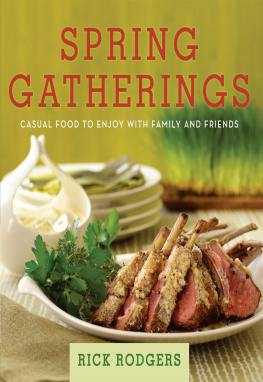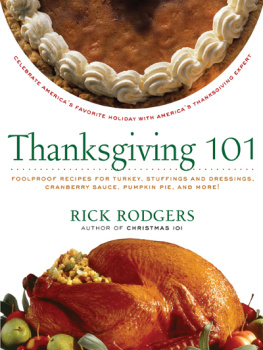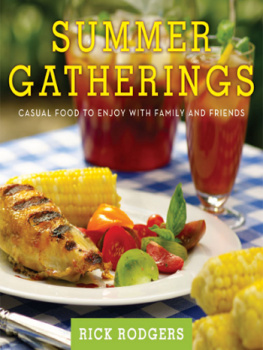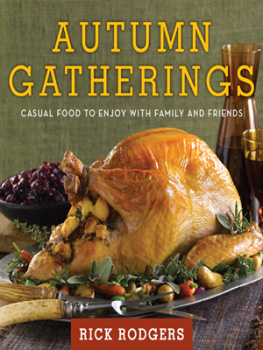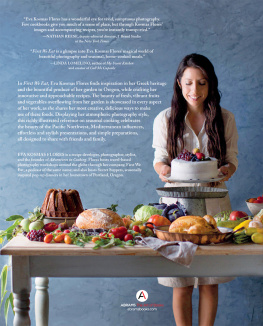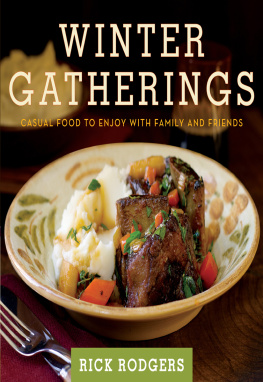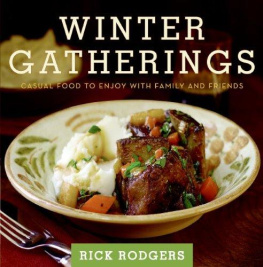I grew up in Northern California, and most people assume that just because the seasonal changes there arent as dramatic as those on the East Coast, there are no seasons at all. The shifts are more subtle, I grant you, but they do exist. Of all the seasons, I anticipated spring the most for many reasons. My birthday is March 21, the first full day of spring, so the seasons start was duly marked with a slice of birthday cake. In spring, you could count on rains to turn the normally golden dry hills a fresh, verdant green, the better for hiking and bike riding. I would also see a shift in what was served on the table, and the foods were my favorites.
When strawberries would make their short appearance at the local farm stand, we would line up for the juicy red berries that would be sliced and sugared to top warm shortcake heaped with thick whipped cream. When asparagus and artichokes were abundant and cheap, we would devour an entire platter of them as a vegetarian Lent or meatless Friday dinner, accompanied by no more than lemon wedges and sourdough bread with butter. Our backyard apricot tree would bloom with countless white flowers that would eventually transform into golden fruit for pies and cobblers and eating out of hand. (In fact, I once ate so many that I took a break from them for a few years.) Neighbors would show up on the porch with offerings of peas from a too prolific vine or mint that had grown out of control, as mint tends to do.
The farm stand in our suburban town had a roster of produce that, of course, changed with the various growing cycles. Our farmers plot wasnt big enough for staggered plantings, so the length of availability was determined by how much he could plant and harvest at once. There was no procrastination, as the supply was limited. When the strawberries were gone, you had to wait a year until the next harvest. This gave a simple dessert of strawberry-rhubarb pie special resonance. It was impressed upon me that its pleasures were fleeting, and to be savored.
This is different from the way we cook today, with produce available year-round. I could buy strawberries in January if I wanted to. But that doesnt mean theyre worth eating. If I want juice-filled, sweet, delicate berries that remind me of the berries of my youth, I still have to wait for their annual springtime appearance.
When I moved to the East Coast, I discovered a new group of seasonal spring bounty. Tightly curled fiddleheads and sorrel were eagerly anticipated. Some items, such as Vidalia onions, Key limes, green garlic, ramps, and garlic shoots, which were formerly regional specialties, were added to the list as they became more readily available.
Back home, springtime holidays meant gathering with loved ones for meals that were out of the ordinarysumptuous roast lamb or ham dinner for Easter, mimosas for a Mothers Day brunch of eggs Benedict, tacos al pastor for Cinco de Mayo, Memorial Day cookouts featuring sweet and smoky ribs, a buffet for a June graduation. When I became a New Yorker, new festivities and their food were added to the list. St. Patricks Day (just a few days before the equinox, it signals the coming seasonal change, so I consider it more of a spring holiday than a winter one), with its raucous huge parade, was a day for everyone to party, Irish or not. I became slightly addicted to hamantaschen, the chunky, triangular cookies of Purim. I was invited to my first Passover seder and learned how to make a more-than-creditable beef brisket and other foods specific to that holy season. (Even when I cant stay for dinner, I deliver a beef brisket to one friends house every year.)
In Spring Gatherings , Ive collected my favorite recipes for this special time of renewal. Just as spring is the time for crocuses, tulips, and daffodils, its also the time for green garlic, cherries, and rhubarb. Ill share recipes that use ingredients in season at the peak of their flavor. The next time you come across an unfamiliar item at the farmers market, youre very likely to find a way to cook it here. Here are recipes, not just for special celebrations, but for anytime that you come together with friends and family. Whether it is a holiday feast on a table set with linen and crystal or a week-night supper at the kitchen table, the meal will be much more satisfying when cooked with the season in mind.

Fava Bean and Mint Hummus
Frittata with Asparagus, Prosciutto, and Chvre
New Potatoes with Fresh Horseradish Dip with Garlic Chives
Shrimp and Avocado Cocktails with Chipotle Vinaigrette
Roasted Artichokes with Green Garlic Goddess Dip
Beer-Batter Okra with Curried Yogurt Dip
Mango-Ginger Mojitos
Berry Julepades
Fava Bean and Mint Hummus
Makes about 2 cups
This lovely hummus-like green puree looks and tastes like spring and is delicious spread on toasted pita or used as a dip for other vegetables. Its worth the effort it takes to shell and peel the fava beans.
1 large, plump head garlic
1/3 cup extra virgin olive oil, plus more for the garlic and for serving
Salt and freshly ground black pepper
2 pounds fava beans
3 tablespoons fresh lemon juice
1 tablespoon chopped fresh mint, plus more for garnish
- Position a rack in the center of the oven and preheat the oven to 400F. Cut the garlic in half crosswise. Drizzle each cut surface with olive oil and season with salt and pepper to taste. Put the two halves back together, wrap in aluminum foil, and place on a baking sheet. Bake until the cloves are very tender and deep beige, about 40 minutes. Unwrap and set aside to cool. Squeeze the garlic out of the husks into a small bowl.
- Meanwhile, remove the fava beans from their pods. Bring a large pot of lightly salted water to a boil over high heat. Add the fava beans and cook until the beans turn bright green, about 3 minutes. Drain and rinse under cold running water. Peel the fava beans.
- Combine the peeled fava beans, roasted garlic, and lemon juice in a food processor fitted with the metal chopping blade. With the machine running, slowly add the 1/3 cup olive oil, then 2 tablespoons water. Add the mint and pulse to combine. Season with salt and pepper to taste. (The spread can be prepared up to 3 days ahead, covered, and refrigerated.) Transfer to a small bowl, garnish with a drizzle of olive oil and some chopped mint, and serve.

Fava Beans
Im warning you right nowpreparing fava beans is a labor of love. The beans require a two-step process to ready them for eating. First, the beans are shucked from their fuzzy green pods and then they are blanched and peeled to remove their waxy skins. Your work will produce beautiful chartreuse beans with a buttery texture and a hint of bitterness to make their flavor interesting. Are they worth the trouble? I think so.
Enlist a friend or two to help with the prep work, for in the end, the big bunch of pods that you start with wont amount to a very large hill of beans. Expect to get about 1 cup of shelled beans for every pound of fava beans in the pods. And keep in mind that most people arent familiar with fava beans, so reserve them for an appreciative audience. (Once, when I was unable to find fresh fava beans for a recipe, I substituted thawed frozen lima beans. I was lucky that no one noticed the difference. I would not have been able to make the switch if I had been serving my Italian friends.)

